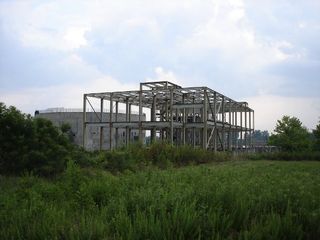This Is What James Cameron's The Abyss Set Looks Like 20 Years Later

If anyone were to look at an abandoned nuclear power plant and think, "We could totally film an underwater epic here," it would have to be James Cameron. In fact, when looking at the details of his extremely exhaustive shoot for his 1989 opus, The Abyss, it almost looks like the James Cameron we know today (good and bad) was forged mostly on that shoot. Even back then, his visions were so huge that they required feats of moving heaven and earth to be attained. It’s always fun to recall a time where directors tried to pull off as many effects with practical means as they could, and a recent find on the Internet helps put just what they were working with into perspective. The following images are pulled from a gallery that shows just what the location used in The Abyss looks like today, over twenty years after they were used to create what would eventually become a well regarded film in the Cameron canon.

Thanks to said gallery, which was discovered on Imgur, we have what are probably the first widely shared shots from the former South Carolina shooting site - a site that still housed the original sets from the film up until 2007. Through all that time, the site was still considered Fox property, despite the fact that it was never used again. Why they were considered off limits, yet never used again, is a rather odd question to ponder. Perhaps the studio wanted to keep those tanks on stand by, so that way if anyone else wanted to use them for a film in the future, they'd be available. Maybe Cameron originally intended to film pieces of a certain future project in those same tanks, and then decided that it'd be too small for his rather gargantuan effort. Whatever the case, the studio was protecting its investment, and who could blame them? If you sank that much money into underwater sets, you'd probably want to keep them available in hopes that you could get your money's worth.

Yet the site has an even more interesting history outside of its film production background, as it was originally going to be the Cherokee Nuclear Power Plant. It was only turned into a film studio about six years after its cancellation, which caught they eyes of Mr. Cameron and his team. Figuring it'd be easier to shoot on a set than in the actual ocean, they went to work building two tanks – the larger "A" tank (which housed the exterior downed submarine, the Montana; as well as the Deepcore rig) and the smaller "B" tank (which was used for miniature shots and interior shots) – to build sets and shoot the film in. After filming, the tanks were just left to sit there with warnings affixed to them that all video and photography were prohibited. As of 2010, the site has come full circle and is going to be demolished for possible work on a new nuclear power plant in the same area.

There's an interesting symmetry to a film that serves as a warning against nuclear weapons being filmed in a plant where radioactive materials could have, under the worst case scenario, done the same level of damage to a populace. It's also a reverent landmark to the old school approach to making movies, as you would probably never see a studio like Fox spending the money and time to convert a facility like this into a filming location. This is especially true thanks to the advances that Cameron has made on Avatar, which would allow him to film a lot of his underwater scenes on a green screened stage. To see what the site looked like back in the day, as well as learn more about the grueling shoot that would only be eclipsed in its difficulty by Cameron's later work on Titanic, here's the first segment of the feature length documentary Under Pressure: Making The Abyss. The first mention/glimpse at the site is at 02:19.
CINEMABLEND NEWSLETTER
Your Daily Blend of Entertainment News

Mike Reyes is the Senior Movie Contributor at CinemaBlend, though that title’s more of a guideline really. Passionate about entertainment since grade school, the movies have always held a special place in his life, which explains his current occupation. Mike graduated from Drew University with a Bachelor’s Degree in Political Science, but swore off of running for public office a long time ago. Mike's expertise ranges from James Bond to everything Alita, making for a brilliantly eclectic resume. He fights for the user.
Most Popular







